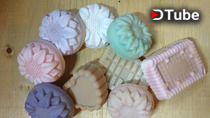
Making your own bar soap is not difficult and many of the necessary ingredients are ones you may already have. The first step is to find a reliable recipe, as exact measurements are very important. We refer to www.thesage.com. where you will find the MMS Lye Calculator.
The ingredients we use are distilled water, lye, olive oil, coconut oil, castor oil, essential oils for fragrance, and coloring.
You will also need a digital scale, bowls, a candy thermometer, gloves and some type of mold to form your soap in.
You must carefully measure the lye, the water and the oils on your digital scale according to your recipe.
The first step is to warm the olive, coconut and castor oils together on the stove to a temp of around 100-125 degrees F.
We take the pre-measured water and lye outside and carefully add the lye to the water. Lye is caustic to skin and produces harmful vapors when mixed with water, so we do this outside while wearing gloves.
The lye and water mixture will immediately get very hot--you can see the steam produced here. It will be left outside for awhile to cool down to 100-125 degrees---the same temperature as the oil.
When the lye water and oil are at the same temperature, the lye is carefully poured into the oil. We use an immersion blender on and off for 15 second intervals until the mixture begins to set, or "to trace" as it is referred to in soapmaking. Tracing looks like a slightly thickened custard. As soon as it begins to trace, we pour in the fragrance and the coloring, then immediately begin to pour the raw soap into the molds.
We want the soap to cool slowly, so the filled molds are covered with cardboard, then with towels and left to cool for 48 hours. When the cooled soaps are hardened, they can be removed from the molds, and cut if desired.
These fresh soaps will be placed on trays and exposed to air for a few months until they are quite firm. Then they are placed into containers, with holes for air
circulation, and a record with the date and type of soap. After about a year, they will be ready for use. You can use them sooner, but the longer you let them cure, the harder the soap will become and the longer the bars will last.
Naturally handmade soap contains no detergents, chemical hardeners, foaming agents or artificial fragrances. It has no filler ingredients or chemical solvents.
Lye sounds a little scary, but all the caustic qualities of the lye are removed when the lye interacts with the oils or fats, and glycerine is created. Soap has been made like this for thousands of years.
▶️ DTube
▶️ IPFS
wah, keren. saya suka post anda. dan sangat menarik untuk kami ikuti. best you post @brimax
Thank you
Thanks for this recipe, in Venezuela we look for that, prepare our things that we do not find for sale!
It's always a good idea if you can do it yourself!
making my own soap, seems interesting though i have never tried to do anything like that.. i will try to make one, thanks for sharing the process
You're welcome
WOW...I should also try this at home.Thanks for sharing :)
Let us know how it works out for you!
Very good information but dont understand the measurement method
@fenmark
That's why we refer to www.thesage.com. where you will find the MMS Lye Calculator.